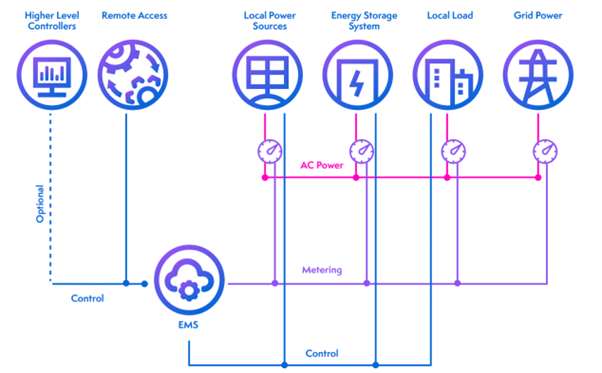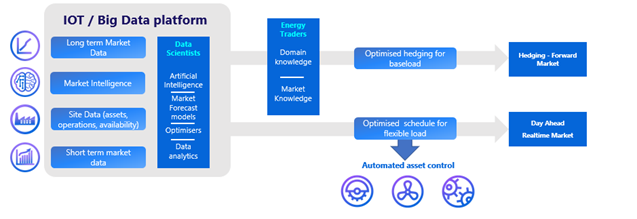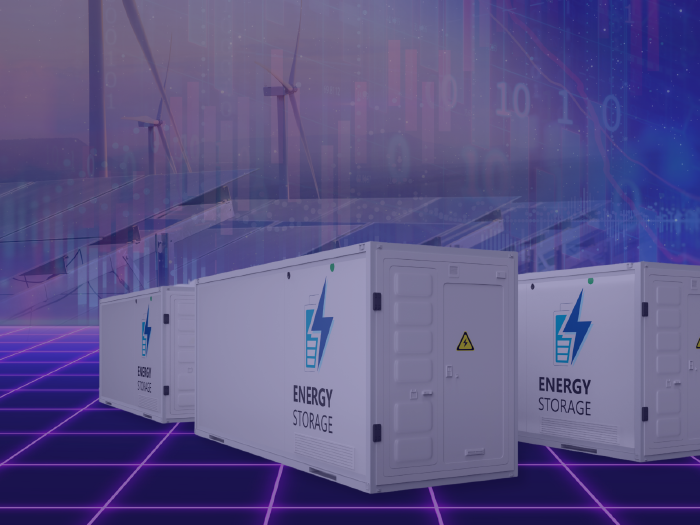News
better business decisions
Posted 1 year ago | 4 minute read

Energy Management Systems | A distributed energy resource management solution
An energy management system (EMS) refers to a suite of tools, comprising both software and hardware components, designed to efficiently allocate energy flows among interconnected distributed energy resources (DERs).
Energy trends of renewable penetration and decentralization of generation assets create new industry challenges. These challenges include integration, coordination, and maximizing return-on-investment (ROI) on distributed energy resources (DERs), while providing network reliability and flexibility.
Companies utilize EMS to optimize assets with the aim of reducing costs and emissions while ensuring grid stability. In this article we explain how EMS systems work and their benefits for businesses in the transition to net zero.
What is an EMS?
An EMS operates by gathering, analyzing, and presenting real-time data, while dynamically regulating energy flows. It serves as a foundational element for upcoming energy scenarios, as it intelligently supervises and manages a diverse array of energy assets within households, buildings, or larger facilities.

Components of an EMS include:
- A system for collecting and processing data that ideally functions independently of specific manufacturers
- Software and algorithms that establish rules and limitations to govern energy asset control based on specific requirements such as maximizing self-sufficiency or adhering to local grid regulations
- A platform enabling users to visualize live and historical data, monitor key performance indicators, set parameters, and manage energy flows
Benefits of EMS
While EMS’ have long prevailed as an energy management tool, they also offer major benefits to other business areas including: finance, corporate social responsibility (CSR) and production optimization. The installation of an EMS allows you to:
- Measure energy consumption
- Reduce energy costs
- Reduce energy needs and carbon emissions
- Comply with regulations and new standards such as ISO 50001 certification
- Engage teams sustainability measures and targets
An EMS provides real-time monitoring, data analysis, key performance indicator measurement, and visualization of energy consumption and savings. This enables more informed and effective decision-making to enhance efficiency, increase sustainability and optimize performance across an entire site. This supports energy and operations managers to ensure assets are working in an efficient manner and to spot problems early.
In addition, by anticipating the energy needs of sites EMS allows energy buyers to continuously optimize purchases, control their budget and manage hedging risks. By optimizing the utilization of each asset, an EMS ensures that costs are constantly minimized (power is drawn from the grid during cheap periods, locally generated electricity is maximized, and consumption is aligned with optimal weather and off-peak demand). In addition, use cases like dynamic load management and peak shaving ensure that power is optimally used within existing grid infrastructure.
The use of battery energy storage under EMS control further enhances emission reduction by storing excess renewable energy for use during peak demand periods.
While taking into account operational constraints, reducing energy consumption allows for cost reductions based on the associated resources, the use of raw materials and the performance of equipment. The production schedule optimization that is made possible by EMS supports businesses reduce their energy consumption and costs.
Monitoring of all CO2 emissions of all sites, EMS systems mean that sustainability and CSR managers can involve their teams, track the reduction of their carbon impact and standardize the counting of the emissions in all the group. Data-driven decision-making, a hallmark of EMS, continuously analyzes consumption patterns, identifying opportunities for optimization and lower emissions.
EMS architecture

Overall, an EMS serves as a crucial tool in optimizing energy management, promoting sustainability, and enhancing efficiency across various sectors and user types. By employing an EMS, businesses gain a competitive edge in an evolving energy landscape characterized by digitization, decarbonization, and decentralization. An EMS enables efficient energy resource management, the alignment of consumption and sustainability goals, and lowered costs. It seamlessly integrates variable renewable energy (VRE) sources into energy systems, to enable faster scaling of clean energy projects and reduced reliance on fossil fuels.
GridBeyond’s energy management software provides intelligence, operations, economics, and markets in one modular solution that enables businesses to easily integrate distributed energy resources. Our AI-powered forecasting, combined with automated control solutions and a smart energy management platform, presents a promising approach to optimize production schedules and minimize energy costs, providing a robust framework for addressing the increasing pressures of energy efficiency and price dynamics.
Harnessing the power of big data and site-specific information from an extensive network of sensors and controllers, GridBeyond’s optimisation model is designed to deliver the best economic production schedule for your facility. Our platform employs AI and machine learning, ensuring that hard constraints such as asset capacity and daily production targets are met while optimizing against energy costs, asset load, and any on-site generation or storage technologies.
Ready to transform your energy into opportunity?
Discover if you can generate new revenues, enhance energy savings and boost sustainability with AI-powered Energy Services.
Book a 20 minute assessment to determine whether your company is eligible.
During the chat, our energy experts will be able to explain the process and answer any questions.







